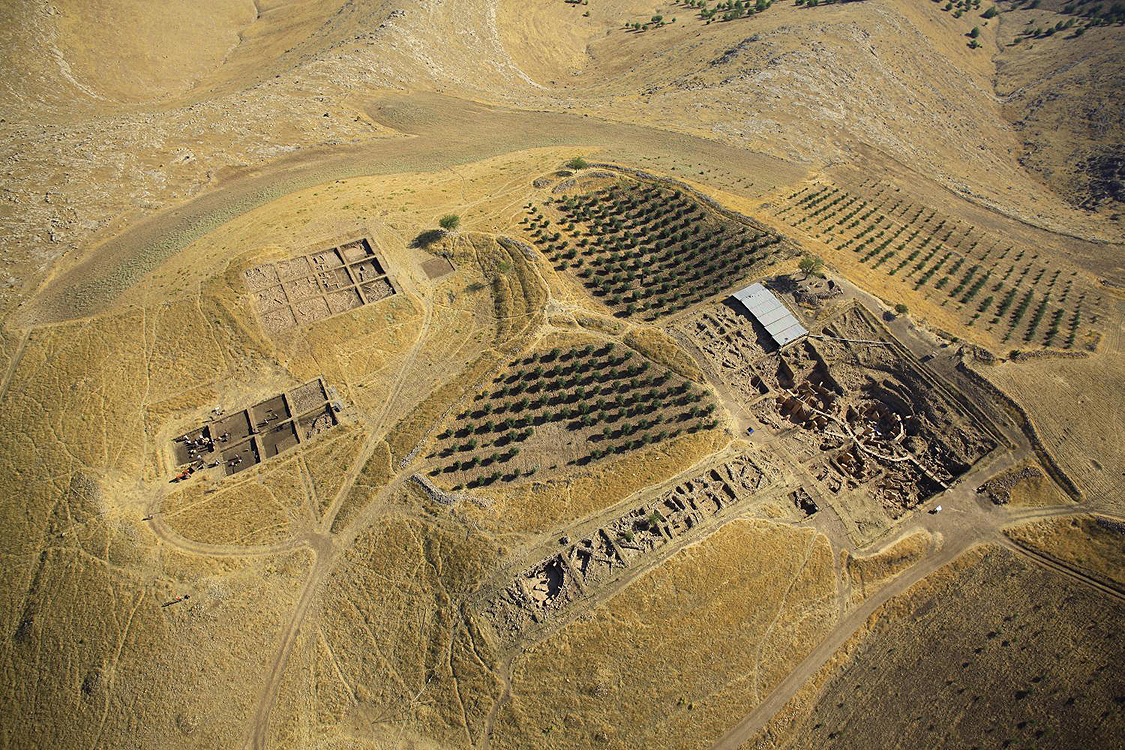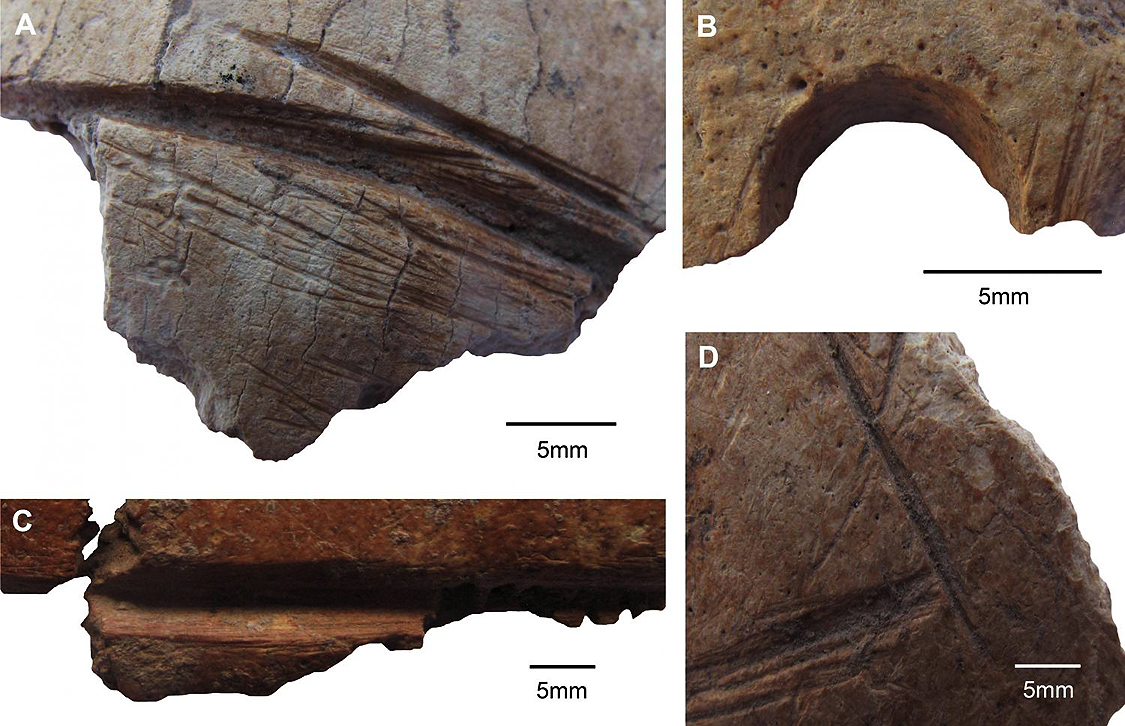


An article by Bob Yirka on phys.org - Skull fragments with carved long, deliberate lines found at Göbekli Tepe - reports on the discovery at the Göbekli Tepe dig site by researchers with the German Archaeological Institute of long, deliberate marks carved into ancient skulls.

Aerial view of Göbekli Tepe. Image: German Archaeological Institute, DAI.
The research has been published on the open access site Science Advances:
Ancient stone pillars offer clues of comet strike that changed human history
Modified human crania from Göbekli Tepe provide evidence for a new form of Neolithic skull cult
Science Advances 28 Jun 2017: Vol. 3, no. 6, e1700564
Abstract:
Archaeological excavations at Göbekli Tepe, a transitional Neolithic site in southeast Turkey, have revealed the earliest megalithic ritual architecture with characteristic T-shaped pillars. Although human burials are still absent from the site, a number of fragmented human bones have been recovered from fill deposits of buildings and from adjacent areas. We focus on three partially preserved human skulls, all of which carry artificial modifications of a type so far unknown from contemporaneous sites and the ethnographic record. As such, modified skull fragments from Göbekli Tepe could indicate a new, previously undocumented variation of skull cult in the Early Neolithic of Anatolia and the Levant.
Ritual use of skulls at Göbekli Tepehttps://t.co/ybFniyxeGX #Turkey #archaeology pic.twitter.com/LPn3rbugJ2
— Bradshaw Foundation (@BradshawFND) June 30, 2017
A pillar (left) from Building D at Göbekli Tepe seen from the southeast. Image: German Archaeological Institute, DAI. Frontal bone fragment (right) of skull 3 with carvings (1) and cut marks (2,3). Image: Julia Gresky, Juliane Haelm, DAI.
The prehistoric site of Göbekli Tepe in what is now southern Turkey is roughly 11,000 years old, and believed to have been constructed as a temple or ritual site. Göbekli Tepe is an example of some of the earliest cultivation, but the cultivation itself was seen as a byproduct of religion. Klaus Schmidt, a German archaeologist and pre-historian, led the excavations at Göbekli Tepe from 1996 to 2014.
Of the rituals, one may have involved using human skulls, based on the numerous fragments found. Researchers believe this may be evidence of one of the earliest skull cults. To support this, researchers report that some of the skull pieces have been found to have lines cut into them.

Details of artificial skull modifications. A, C, D: carvings, B: drilled perforation. Image:Julia Gresky, DAI.
The team determined that the skull fragments they found with the unique marks on them belonged to just three individuals. Each had deep straight-line grooves carved into the bone and one of them also had a hole drilled through its top. The grooves were found to measure between 0.2 and 4 mm deep and were clearly made by a person using stone tools, rather than by another animal or other natural process. Also, it was determined that the grooves were made after the person had died - there was no bone growth suggesting natural repair. Also, it appeared likely that the grooves had been made shortly after the person had died, while the bone was still relatively elastic.
Research into the purpose of this activity continues.
by Bradshaw Foundation
Monday 04 December 2023
by Bradshaw Foundation
Friday 30 June 2023
by Bradshaw Foundation
Thursday 06 April 2023
by Bradshaw Foundation
Thursday 24 November 2022
by Bradshaw Foundation
Tuesday 27 September 2022
by Bradshaw Foundation
Thursday 08 September 2022
by Bradshaw Foundation
Tuesday 19 July 2022
by Bradshaw Foundation
Monday 06 June 2022
by Bradshaw Foundation
Friday 11 March 2022
by Bradshaw Foundation
Wednesday 02 March 2022
by Bradshaw Foundation
Thursday 26 August 2021
by Bradshaw Foundation
Monday 16 August 2021
by Bradshaw Foundation
Tuesday 06 July 2021
by Bradshaw Foundation
Thursday 06 May 2021
by Bradshaw Foundation
Thursday 06 May 2021
by Bradshaw Foundation
Tuesday 16 March 2021
by Bradshaw Foundation
Monday 04 December 2023
by Bradshaw Foundation
Friday 30 June 2023
by Bradshaw Foundation
Thursday 06 April 2023
by Bradshaw Foundation
Thursday 24 November 2022
by Bradshaw Foundation
Tuesday 27 September 2022
by Bradshaw Foundation
Thursday 08 September 2022
by Bradshaw Foundation
Tuesday 19 July 2022
by Bradshaw Foundation
Monday 06 June 2022
by Bradshaw Foundation
Friday 11 March 2022
by Bradshaw Foundation
Wednesday 02 March 2022
by Bradshaw Foundation
Thursday 26 August 2021
by Bradshaw Foundation
Monday 16 August 2021
by Bradshaw Foundation
Tuesday 06 July 2021
by Bradshaw Foundation
Thursday 06 May 2021
by Bradshaw Foundation
Thursday 06 May 2021
by Bradshaw Foundation
Tuesday 16 March 2021
Friend of the Foundation











